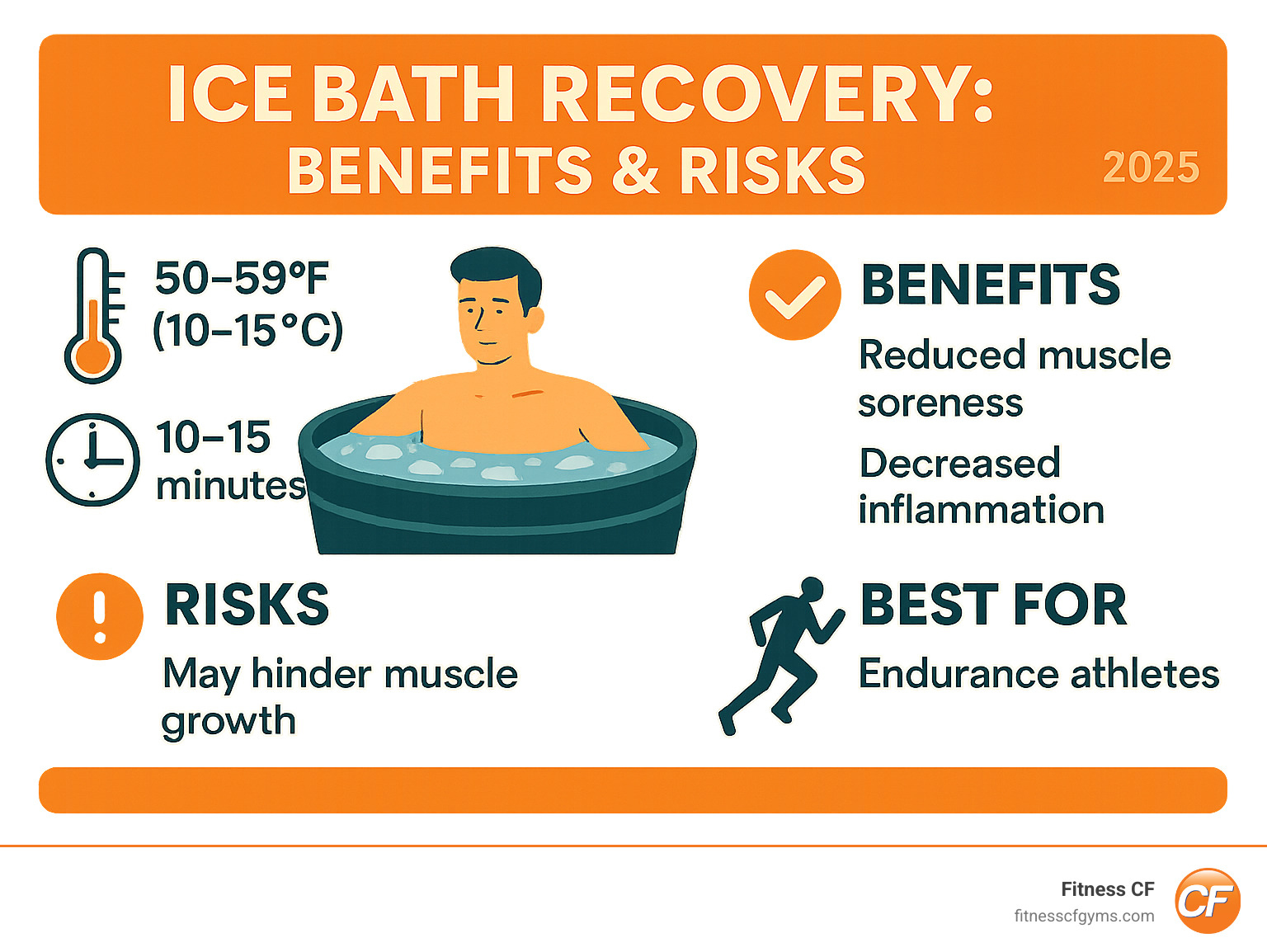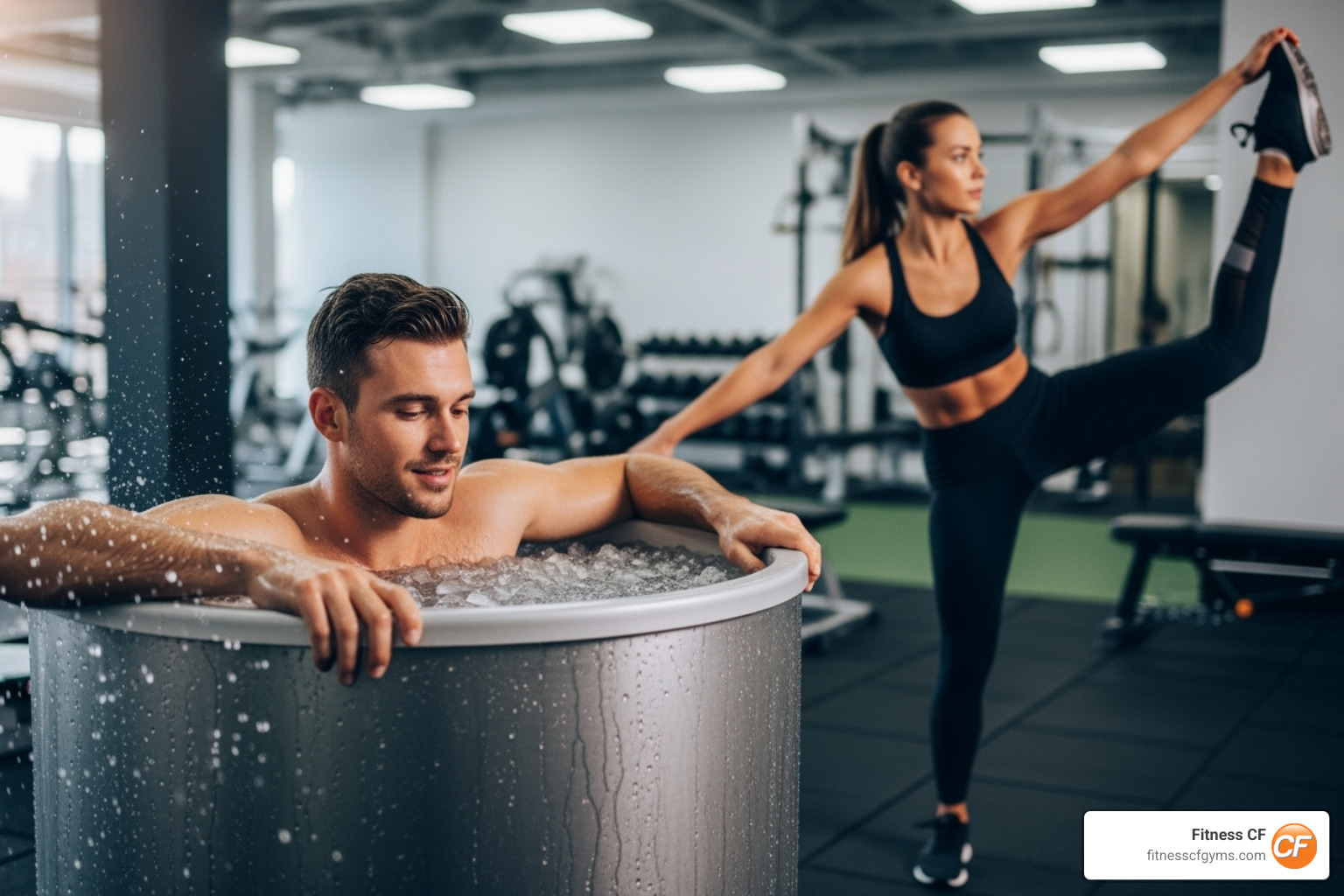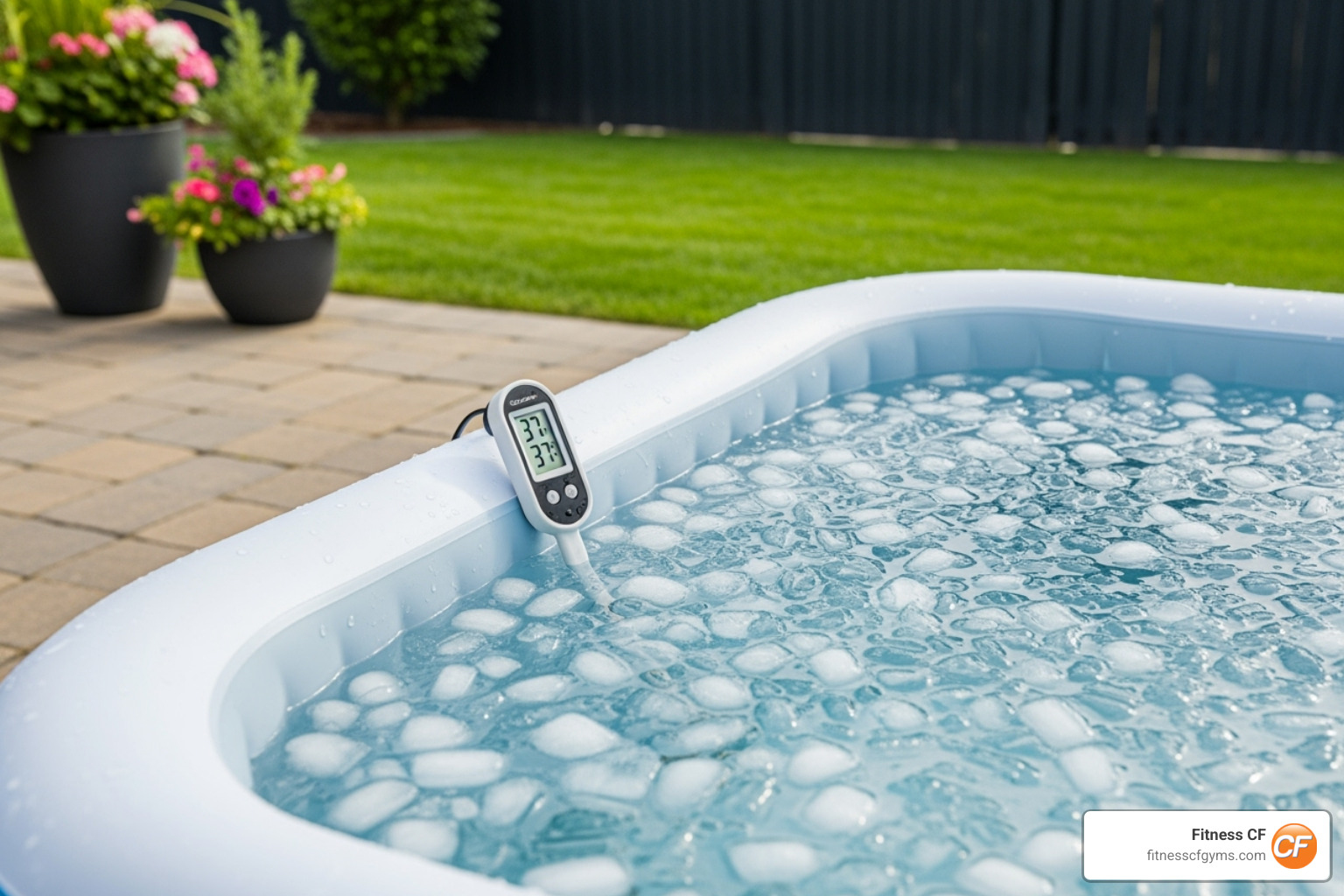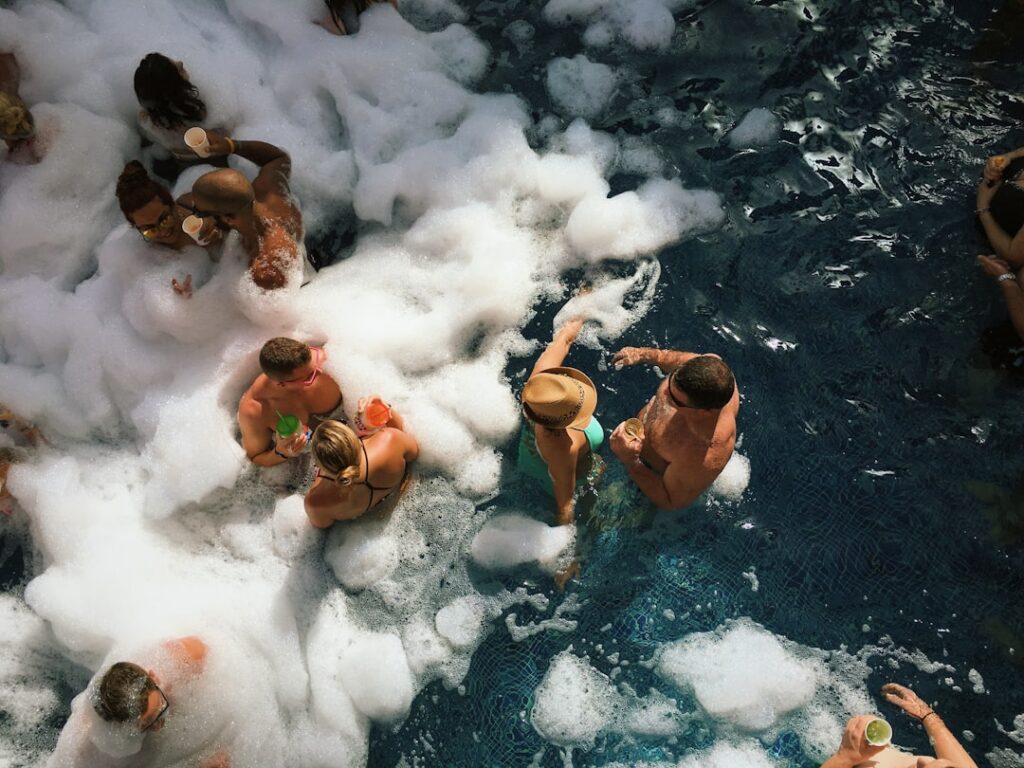Why Ice Baths Have Become a Recovery Sensation
The question of why are ice baths good for muscle recovery is popular in the fitness world. The short answer is that ice baths may reduce muscle soreness and speed up recovery by decreasing inflammation and flushing out metabolic waste like lactic acid.
Here’s what the science shows about ice baths for muscle recovery:
- Reduces muscle soreness: Cold water immersion significantly lowers delayed-onset muscle soreness (DOMS) immediately after exercise.
- Decreases inflammation: Studies show reduced levels of creatine kinase, a marker of muscle damage, at 24 hours post-exercise.
- Flushes waste products: Cold exposure helps remove lactate from muscles at 24 and 48 hours after training.
- Provides mental benefits: Athletes report feeling more alert and less fatigued after cold water therapy.
- Works best for endurance: Most effective for athletes with quick turnarounds between competitions.
However, there’s a catch: while ice baths help you feel better faster, they might slow muscle growth and strength gains over time by interfering with the muscle-building signals sent after resistance training.
Cold water immersion has grown in popularity, with many athletes and fitness enthusiasts touting it as a quick fix for workout recovery and wellness. Understanding why are ice baths good for muscle recovery requires looking beyond the hype. The best recovery method depends entirely on your specific fitness objectives, whether you’re focused on endurance, strength, or overall healthy living.

The Science Behind the Shiver: How Ice Baths Impact Your Body
When you submerge in icy water, your body initiates a series of physiological responses that can aid muscle recovery. The science behind why ice baths are good for muscle recovery is fascinating, starting with the body’s protective reaction to cold.

Vasoconstriction and Reduced Blood Flow
The primary response to cold is vasoconstriction, the dramatic narrowing of your blood vessels. This process pulls blood away from your extremities to protect vital organs. For muscle recovery, this constriction helps reduce swelling and inflammation in tired muscles.
When you exit the bath, your blood vessels dilate, creating a powerful flushing effect as fresh, oxygen-rich blood rushes back into your muscles. This constriction-dilation cycle acts like a pump, helping to clear metabolic waste and deliver nutrients, which is a key reason why ice baths are good for muscle recovery.
This process essentially gives your circulatory system a workout while your muscles get a break, promoting more efficient recovery.
Taming the Inflammatory Response
Intense exercise, like a challenging strength training or cardio session, creates tiny micro-tears in muscle fibers. This is a normal part of getting stronger, as it triggers an inflammatory response necessary for repair and growth. However, excessive inflammation leads to soreness and stiffness.
Ice baths help by dampening the initial inflammatory signaling and reducing metabolic activity in the muscles. Research shows cold water immersion can lower levels of creatine kinase (CK), a marker of muscle damage, 24 hours post-exercise. The goal isn’t to eliminate inflammation, which is vital for adaptation, but to manage it for consistent training.
For more detailed information about how cold water affects muscle damage markers, check out a study on CWI and muscle damage markers.
Numbing the Nerves for Pain Relief
One of the most immediate benefits of an ice bath is that it makes you feel less sore. This isn’t just a placebo effect. Cold temperatures slow down nerve conduction velocity, which means your nerves transmit pain signals to your brain less intensely.
This natural analgesic effect can provide significant pain relief, especially for Delayed-Onset Muscle Soreness (DOMS). While it doesn’t fix the underlying muscle damage, this reduction in perceived pain is valuable for athletes needing to perform again soon, as it can improve movement and training consistency.
This immediate relief is a genuine nervous system response, giving you a well-deserved break after a hard workout.
If you’re interested in learning more about how cold therapy affects pain tolerance, you can explore scientific research on cryotherapy and pain tolerance.
The Great Debate: Do Ice Baths Really Boost Muscle Recovery?
While the science is compelling, the real-world effectiveness of ice baths depends on your specific recovery needs and fitness goals. The research shows a complex picture, with benefits varying based on the type of athlete and activity.

The Case for Cold: Reducing Soreness and Aiding Performance
Ice baths excel at reducing soreness and helping athletes feel ready for their next session. They consistently lower DOMS and perceived fatigue immediately after exercise. This is especially beneficial for tournament recovery or when athletes have quick turnarounds between events.
Sports where athletes often use ice baths for this purpose include:
- Soccer
- Rugby
- Marathon Running
- CrossFit competitions
- Cycling
- Swimming
While cellular recovery might not be faster, the perceived improvement in feeling and performance is a significant benefit worth considering.
The Power of the Mind: Psychological Benefits
A significant part of why ice baths are good for muscle recovery is psychological. The benefits are real and powerful. Many people report feeling more alert and focused after an ice bath, an experience that builds mental toughness.
A small study on alertness and mood found that cold water immersion boosted alertness and reduced anxiety. This is partly due to vagus nerve stimulation from the cold, which can help lower stress and improve well-being, contributing to better overall recovery from exercise.
How do ice baths compare to other recovery methods?
Ice baths are just one tool among many. Active recovery, such as light stretching or foam rolling, can be just as effective for reducing inflammation and promoting blood flow, as shown in a study comparing CWI to active recovery.
Contrast water therapy (alternating hot and cold) offers similar flushing benefits and may be more comfortable for some. Even passive recovery with proper nutrition and hydration is effective.
A comprehensive recovery plan should combine multiple strategies, including quality sleep and a healthy diet. Ice baths can be a part of this, but they don’t replace other healthy living practices.
The Chilling Truth: Why Are Ice Baths Good for Muscle Recovery but Potentially Bad for Gains?
While ice baths aid short-term recovery, they may hinder long-term muscle-building goals. This creates a conflict between feeling better now and adapting for future strength, a key consideration when deciding if ice baths are right for you.

The “Recovery vs. Adaptation” Conflict
Strength training creates micro-tears in muscle fibers, triggering an inflammatory response that initiates muscle protein synthesis—the process of rebuilding stronger muscles. Jumping into an ice bath immediately after can interrupt this process.
The cold-induced vasoconstriction reduces blood flow, slowing the delivery of nutrients and signaling molecules needed for growth. A 2015 study on reduced muscle mass found that post-exercise cold immersion led to less muscle growth, as it can disrupt key muscle-building signals like the mTOR pathway.
Why are ice baths good for muscle recovery in endurance athletes?
For endurance athletes focused on cardio-based activities like running or cycling, the goal is consistent performance, not maximal muscle growth. During multi-day events or high-volume training, managing cumulative inflammation is key.
Ice baths help by reducing inflammation between sessions, allowing athletes to maintain training intensity and avoid excessive soreness. For these athletes, the benefits of sustainable performance and a healthy living approach outweigh any potential interference with muscle-building signals. The cardiovascular benefits of their training remain the priority.
Why are ice baths a concern for strength and hypertrophy goals?
For those focused on strength training and hypertrophy (muscle growth), the post-workout inflammatory response is a vital signal for adaptation. Ice baths can blunt these anabolic signals, slowing the delivery of nutrients needed for muscle protein synthesis.
A systematic review on blunted gains confirms that regular cold immersion after resistance exercise can lead to decreased strength gains and muscle growth. This highlights the trade-off between immediate comfort and long-term adaptation. For strength goals, it’s often better to let the natural recovery process unfold without cold intervention.
Your Guide to Taking the Plunge: Best Practices for Ice Baths
If you’ve decided ice baths align with your fitness goals, it’s crucial to approach them safely and effectively. A thoughtful method will maximize benefits while minimizing risks.

The Perfect Protocol: Temperature and Duration
Aim for a water temperature of 10-15°C (50-59°F). Use a thermometer and add ice gradually to cold water to reach the target temperature. For duration, 10-15 minutes is the optimal window for recovery benefits, according to research on optimal time and temp.
Beginners should start with just 1-2 minutes and gradually increase the time as their body adapts. Always listen to your body; uncontrollable shivering is a sign to get out.
Timing is Everything: When to Use an Ice Bath
Timing is crucial for aligning ice baths with your goals and understanding why are ice baths good for muscle recovery in your specific context.
- For endurance activities, an ice bath immediately after exercise can reduce soreness and fatigue, aiding quick recovery.
- For strength training, it’s better to wait 24 to 48 hours after a workout. This delay allows the necessary inflammatory processes for muscle growth to occur.
- On rest days, using an ice bath is another effective strategy to promote recovery without interfering with adaptation.
Safety First: Minimizing Risks
Safety is paramount. The main risks include hypothermia (a dangerous drop in core body temperature) and the cold shock response (a sudden gasp and increased heart rate that can be risky for those with heart conditions). The cold also puts cardiovascular stress on the heart and can cause nerve damage with prolonged exposure.
Individuals with the following conditions should avoid ice baths or consult a doctor first:
- Heart rhythm abnormalities
- High blood pressure
- Raynaud’s phenomenon
- Peripheral artery disease
- Diabetes with neuropathies
- Open wounds or active skin conditions
As highlighted by the National Center for Cold Water Safety warning, it’s crucial to understand these risks. Never take an ice bath alone, especially when starting out.
Frequently Asked Questions about Ice Baths
How long should I stay in an ice bath?
The recommended duration is 10 to 15 minutes in water between 11-15°C (50-59°F), which is optimal for fatigue recovery. If you are new to ice baths, start with only 1-2 minutes and gradually increase the time as you acclimate. Listen to your body; if you shiver uncontrollably, it’s time to get out. Even very short exposures can offer some benefits, so there’s no need to push past your comfort level initially.
Do ice baths burn fat?
While not a primary weight-loss tool, ice baths can contribute to metabolic health. The body burns calories to stay warm in cold water. More importantly, cold exposure activates brown fat, a type of fat that generates heat by burning calories. Regular cold immersion may help activate these cells, supporting overall metabolic function. An ice bath is not a substitute for exercise and nutrition, but it can be a complementary part of a healthy living routine.
Can I take an ice bath every day?
Daily ice baths are not recommended for everyone. For general wellness, two or three times a week is often sufficient. If your goal is strength training, daily post-workout ice baths can hinder muscle growth by repeatedly blunting the necessary inflammatory response. For strength goals, it’s better to use them strategically, perhaps 24-48 hours after a session or on rest days. In contrast, endurance athletes doing intense daily cardio may find daily ice baths beneficial for managing soreness and maintaining performance, as their primary goal is not muscle hypertrophy.
Conclusion: Is an Ice Bath Right for Your Fitness Journey?
After exploring the science, the answer to why are ice baths good for muscle recovery clearly depends on your fitness goals. For endurance athletes, they are excellent for reducing immediate soreness and aiding quick turnarounds. For those focused on building muscle and strength, however, immediate post-workout ice baths can interfere with the body’s natural adaptation processes needed for growth.
Ice baths are one tool in a larger recovery toolkit. The foundation of any successful fitness journey and healthy living plan is built on consistent training, quality sleep, and proper nutrition. Whether you’re focused on the proven benefits of strength training or the heart-healthy advantages of cardio, listening to your body is key.
At Fitness CF, we understand every journey is unique. We offer diverse options, from high-energy spin classes to restorative yoga and personal training, to support you in building a sustainable and enjoyable fitness routine that aligns with your goals.
Explore our fitness classes for a complete workout routine and find how we can help you on your path to becoming your healthiest, strongest self.







